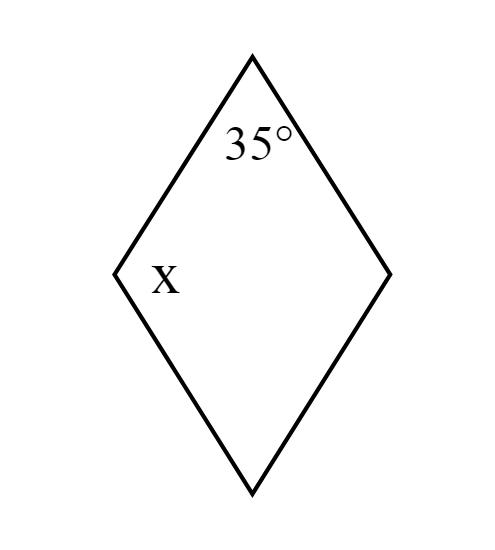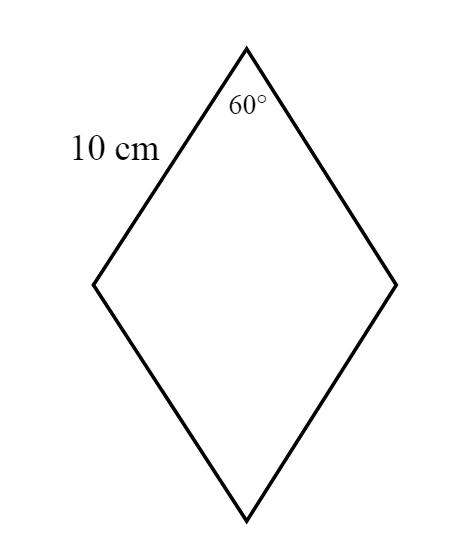ASVAB Mathematics Knowledge Test 2
What is the value of x in the rhombus seen in the figure?

Which of the following angles is obtuse?
An obtuse angle is one which is greater than 90 degrees. Acute angles are less than 90 degrees, and right angles are exactly equal to 90 degrees.
The circumference of a circle is 20 cm. What is the approximate radius of the circle?
The formula for the circumference of a circle is C = 2πr. Plug in the given circumference and solve for the radius. C = 2πr 20= 2πr 10 = πr Use 3.14 as an approximate value for π and divide to solve. Round to the nearest tenth. r = 3.2
Which of the following statements about trapezoids is true?
Trapezoids do not need to have any angles that are equal to one another. If the two bases of a trapezoid are parallel, then it is possible to form a trapezoid with 2 triangles and a rectangle, but never 3 triangles.
Solve for the value of x in the following system: 2x + 4y = 15 3x - 4y = 10
To solve this system, we will first add the two equations together in order to eliminate the y term. This gives us 5x = 25. Solving for x, we find that x is equal to 5.
A rectangular plot of land is measured to be 130 feet by 220 feet. Its total area is:
The area of a rectangle is equal to its length x width. This piece of land's area is thus 130 x 220, which is equal to 28,600 feet square.
Two parallel lines are intersected by a third line, which is perpendicular to the first parallel line. The value of another angle made by the intersecting lines is:
If the first line is intersected and forms a 90 degree angle, then that means that all other angles are also equal to 90 degrees.
If a square is cut in half across its diagonal, the formed triangles will have angles of:
If a square is split in two at its diagonal, then its angles will also be bisected. A bisection of a 90 degree angle is 45 degrees. Thus, the formed triangles would have angles of 45, 45, and 90 degrees.
How much water could a container hold that measures 8cm by 12cm by 10cm?
The volume of the container is equal to the length times the width times the height. V = lwh V = 8(12)(10) V = 960 cc2 Cubic centimeters are equal to mL, so a container with a volume of 960 cc2 can hold 960 mL.
What is the distance between the points (2,4) and (-1, 8)?
To find the distance, we use pythagoreas theorem. First calculate the distances in terms of x and y. The x difference is 3 and the y difference is 4. Then, √(32 + 42) = distance, which is 5.
A given rectangle has an area of 24 square feet. Which of the following cannot be one of its side lengths?
Without knowing either side length, there are infinite possibilities of side lengths for a rectangle of area 24 square feet. For example, you could have one side of 480 feet, and one side be 0.05 feet, and still get an area of 24 square feet.
Simplify the expression: 3x + 6.5x2 = ?
We cannot add two terms that have variables with different exponents. As a result, this expression cannot be simplified.
What is the area of an isosceles right triangle that has one leg that measures 4 cm?
If the triangle is isosceles, that means its two legs are equal in length, so they are both 4. In a right triangle, the two legs are the base and the height. The area of a triangle is equal to ½ bh, so the area = ½(4)(4) = 8 cm.
The base of a right triangle is 1 foot, and the interior angles are 45-45-90. What is its area?
If you draw out this triangle, you'll see that is a right isosceles triangle with two equal sides of 1 foot. This means that the base is 1 foot and the height is 1 foot. Using the formula for area of triangles, A = 1/2bh, we find the area is 0.5 feet squared.
Y2-49 = 0. Y could equal:
Add 49 to both sides to move it to the other side of the equation and you are left with y2 = 49. Take the square root of both sides to solve for y. √49 = 7.
Charles walked all the way around a crop circle and found that traveled 5.5 miles. If he had walked directly through it and passed the center, how much shorter would he have walked?
The circumference = diameter x pi, and the diameter = circumference/pi. The diameter is found to be 1.75 miles, meaning if he had walked straight through, he would have walked 5.5 - 1.75, or 3.75 miles shorter.
What is the perimeter of the rhombus shown in the figure?

The sides of a rhombus are all equal. All four sides have a length of 10 cm each, so the perimeter is 10 + 10 + 10 + 10 = 40 cm.
If a circle has a diameter of 1.5 feet, what is its circumference?
The diameter of a circle multiplied by pi is equal to the circumference. Thus the circumference is equal to 1.5 π, or about 4.71 feet.